During the summer of 2019, we were introduced to Maurice Suckling and his very interesting design Freeman’s Farm 1777 from Worthington Publishing. In this wargame covering the Saratoga Campaign of 1777 during the American Revolutionary War, Maurice used this very interesting spatial focus for formations in battle and introduced a very cool mini-economy in the use of Momentum Cubes that were garnered from the play of Activation Cards to take re-rolls and purchase very interesting Tactics Cards that could be used to simulate or recreate some of the more interesting parts of the historical battle.
I really enjoyed that game and found the concepts very interesting and innovative and hoped that they would be used in future games. Well, looks like my wish came true as I found that Maurice was once again working with Worthington Publishing on a game covering the Battle of Chancellorsville in 1863 during the American Civil War using a similar system but adding in some other interesting elements such as hidden movement. I heard that the game was heading to Kickstarter and I reached out to Maurice to get some information about the design.
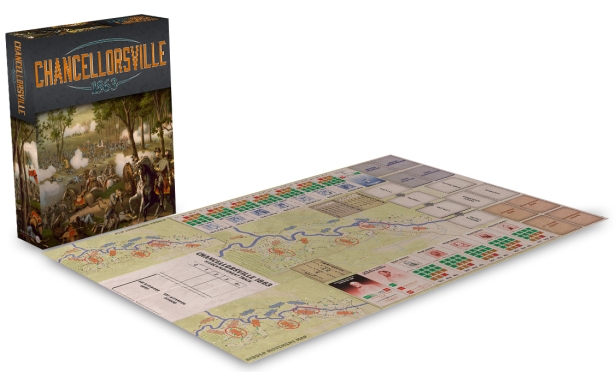
Grant: First off Maurice please tell us a little about yourself. What are your hobbies? What’s your day job?
Maurice: I’m a video games writer, narrative designer, narrative director, sometimes producer, creative director, voice director, or consultant of some kind or other. I’ve been making video games since the last century – my first game was Driver back in 1999. Since then I’ve rather lost count of how many published games I’ve worked on – it’s over 50. Some of the best known titles that I’ve been involved with in some form or another are Borderlands: The Presequel, Civilization VI, Killing Floor 2, and Fortnite.
I’ve been working on a couple of other video games recently. Lost Words is a story-driven game set in the pages of a girl’s diary – and in her imagination. I’ve been working as a narrative consultant and writer. It will be out in the spring. Here is a link to the game page: www.lostwordsgame.com
I’ve also been working as a voice director and voice producer for the WWII leadership RPG Burden of Command. You can find out more information at the following link: https://burdenofcommand.com/
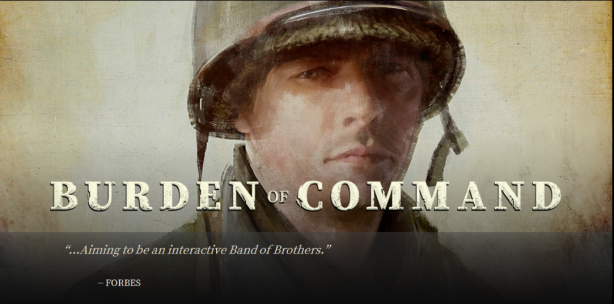
These days I’m also Professor of Practice at Rensselaer Polytechnic Institute in Upstate New York, in the Games Simulation Arts and Sciences program, where I teach various courses, including writing for games, board games as storytelling systems, and historical simulations. We’re about to get our first graduate students in the fall, and I’m looking forward to seeing what they bring – I’m already seeing some board game research projects on the horizon.
As for hobbies – playing board games, D&D, video games, playing soccer, reading history, even writing some fiction from time to time…
Grant: How did you get motivated to break into game design? What have you enjoyed most about the experience thus far?
Maurice: Like many of us in this hobby, I suspect, I was into history, miniatures, and games from a really early age. I was making my own (pretty rudimentary) games at least from the age of 7. Games was how I became interested in history, which fueled more interest in games. I used to write stories and play/make games. When I was 11 my head teacher called me mum to school to tell her he was worried because that was all I was interested in, and in his sage view, no one ever had proper careers writing or making games…
Around the late 80’s to mid-90’s I lost touch with wargaming and board games, but started to get back in touch with it after playing Reiner Knizia’s Battleline and Fantasy Flight’s Battlestar Galactic. After that I kept making analog games while my video games career developed, but it was often incredibly hard to find the right kind of time to devote to ideas. When I stopped working full time in video games in 2016 I could muster the time to put my own ideas together.
What have I enjoyed most about the experience of making games? The Worthington guys. That’s the answer. I’ve had a blast working with them. I like how they think about games as experiences, I like how they think about the business, I like how they work, I like spending time with them, and I love how they like my designs and support them.
Grant: What do you find most challenging about the design process? What do you feel you do really well?
Maurice: Pacing can be hard – keeping all the other bits of life going whilst sustaining interest in a project already commenced, alongside multiple others that are developing in your head can be challenging. Getting to a prototype, testing, and publication without being too fast or too slow can be difficult. Something isn’t necessarily better because you spend longer on it. Sometimes you lose the mojo you had on it that catalyzed it in the first place, and you spend time trying to get that back.
Hmm. That’s interesting to think about…I think I’m good at not being a lazy designer. I tend to be good at challenging myself as to why I’m making a certain game a certain way, and why I’m incorporating certain mechanics, or why I feel they have thematic resonance. I think I’m also quite good at distilling ideas into accessible forms. Rachel Simmons (Bonaparte at Marengo, Napoleon’s Triumph) has talked about games, optimally, being engines for efficiently translating ideas into action. I see it the same way. I think once we accept levels of abstraction in our game designs (and, really, how can we not?) we can accept that we can often be better at making play easier to understand and faster to move from idea to action.
Grant: Why did you want to do a game on the Battle at Chancellorsville from the American Civil War?
Maurice: Right – it’s not as if it’s a subject that hasn’t been touched before. But I saw it as a suitable topic to explore the Battle Formations System. The scale and the extent of movement were design challenges I was keen to address.
It’s a fascinating battle/campaign from the perspective of trying to second guess your opponent. I wanted to represent the strategic level decisions Hooker and Lee faced as the campaign reached its climax. How and where should Hooker strike, and with what force? How should Lee respond? Should he divide his forces, or attempt to hold a broad front?
Grant: What do you feel is important to model from the Civil War in the design?
Maurice: I think this really depends on the scale you’re modelling. The issues at the tactical level are different from the strategic ones, or even grand strategy. At the strategic level, the lack of definite information about an enemy’s presence and strength seems fundamental – yet designers seldom deliver on this. The lack of control commanders had over their units was also key – which the constraints of the activation system already give us a way of addressing.
Grant: What challenges did the design present you with?
Maurice: I really couldn’t see any way of faithfully representing the high level strategic decisions without incorporating hidden movement. If Lee can see what Hooker is doing, and vice versa, the whole conundrum for them both is essentially blown, and there is so much fun players are missing out on. I wanted to give players that anxiety-fueled thrill of not being certain where the enemy was.
I also wanted to see if I could find a way of representing Jackson’s famous flanking maneuver that might feel fresh to players, and I wanted to explore some other developments to the system.
It’s clear why board games don’t often model hidden movement. Board games are highly disadvantaged at this over video games. But I wanted to tackle it, and felt it was something the hobby should look at again. Mini maps and player screens come with all manner of complications (does a different scale for the mini map mean a different scale for the pieces?), are the screens too short, so they don’t do their job, are they too tall so they obscure the game board and you lose that social dimension that players usually like in board games?
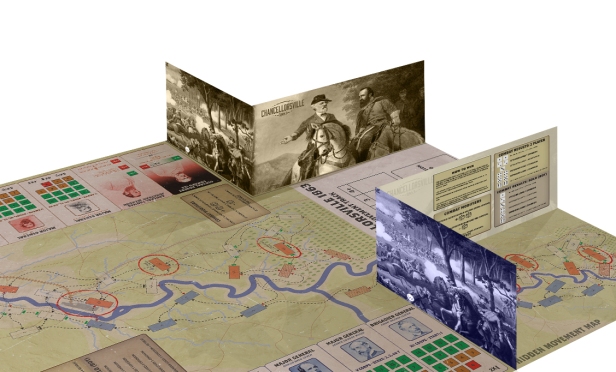
Another considerable challenge was figuring out how to retain hidden movement for the solo version of the game. You, as the player, would, of course, know where all your own units were, but I wanted you to not know where all the enemy’s units were until they showed up, and to make that playable with the minimum of effort on the part of the player.
Grant: What sources did you use for the design and which would you recommend as a one source must read?
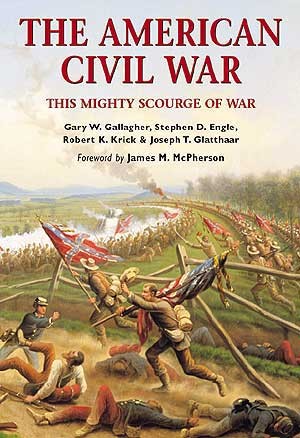 Maurice: Osprey’s The American Civil War, and their Chancellorsville 1863 campaign series, were especially helpful. More generally I also went back to Shelby Foote’s The Civil War, and Ken Burns’ Civil War documentary were useful. I also walked around parts of the battlefield with my friend Derek (current Lords of Waterdeep world champion).
Maurice: Osprey’s The American Civil War, and their Chancellorsville 1863 campaign series, were especially helpful. More generally I also went back to Shelby Foote’s The Civil War, and Ken Burns’ Civil War documentary were useful. I also walked around parts of the battlefield with my friend Derek (current Lords of Waterdeep world champion).
Grant: What games have inspired your thoughts on the design?
Maurice: The clean look of W1815 was still in my head. But other than Freeman’s Farm, I wasn’t consciously drawing on any other games. I wanted to keep a clear head so the approach felt as fresh as possible.
Grant: Using the same system as your recent Freeman’s Farm 1777, how did you balance the problem of using too much and making a similar game versus starting with a new system?
Maurice: I tried to let the subject matter dictate things. This naturally took the design in all kinds of different directions, given how different the Battle of Chancellorsville is from Freeman’s Farm. The scale meant I had to look at all kinds of elements. There’s no longer a combined morale and casualty block concept. Instead they’ve both been combined into the concept of Cohesion. Activations reduce Cohesion, as do combat losses. When Cohesion reaches 5 you start to roll, as per the Morale tests from Freeman’s Farm. Fail those tests or reach 0 and the unit disintegrates.
I wanted to retain the basic shape of the game, the same duration, the same combat, and the same approach to the Momentum currency and Tactics Cards. But I knew I wanted some new Tactics Cards too. In the deck of 36 cards, 16 are entirely new concepts, which felt like the right kind of balance. The other 20 are concepts we’ve seen in Freeman’s Farm, but now have a somewhat different application.
Ultimately it came down to the subject matter and scale, and a gut instinct on what players would respond well to. So we shall see how much I got right…
Grant: What has changed in the system used in Chancellorsville 1863?
Maurice: Lots has changed including the following:
- Free movement – no spaces restricted, other than universal combat/stacking limitations.
- Combat occurs in the same space (not between adjoining space
- Hidden movement.
- Cohesion combines Morale and Casualties concepts.
- 1/3 of the Tactics Cards are new.
- Different commander abilities.
- Reinforcements.
- Addition of Prepared defenses.
- Take and retain objectives for a win (although having three units destroyed still means defeat).
Grant: Let’s talk about this new concept of hidden movement as it seems like an interesting addition to the system. I understand the game uses mini maps that allow for this hidden movement. How does this work?
Maurice: At the start of the game some units on each side are visible. This is mostly because they are adjacent (units adjacent to enemy units are always visible on the main map.) Other units are hidden, placed on spaces on their respective mini map hidden behind a screen, in one of a variety of spaces. The mini map is a smaller representation of the main map, with the same movement arrows and nexus points but with the same scale for ‘spaces’ so the same blocks fit on both maps. Each side has their own mini map.
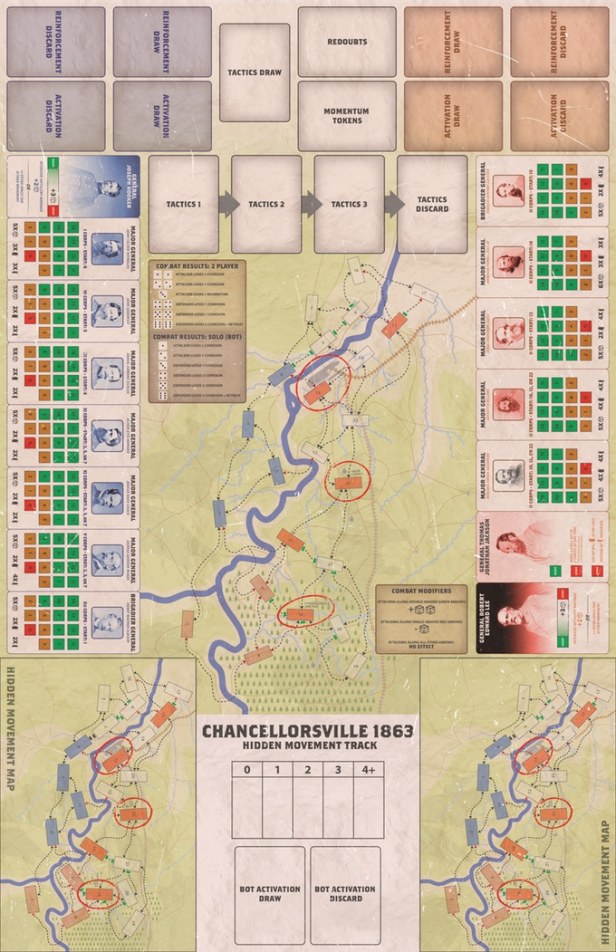
If units move into a space on the mini map that is adjacent to a space occupied by a unit on the main map, that unit is transferred to the main map.
There are also some spaces – deep inside the enemy’s lines of communication – and moving onto those spaces on the mini map compels an immediate transfer to the main map.
In addition, there are some spaces where the lead Union units are visible. This represents Jeb Stuart’s cavalry tracking the Union advance on the Confederate left.
These interlinking systems mean there should be a clear and easy transfer between the mini maps and the main map.
Grant: What does this mini map look like and how many iterations are included?
Maurice: Hopefully you can see from this image below taken from a prototype board, with work in progress artwork.
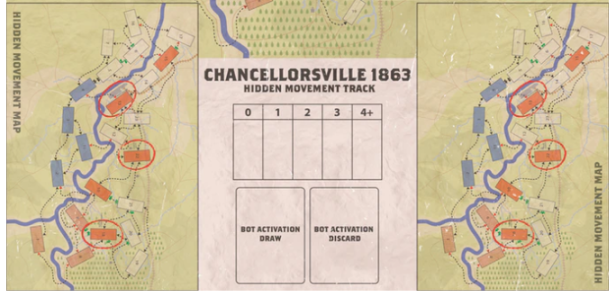
Players just have one mini map each, which are funtionally identical. The choices players have at set-up give plenty of opportunities for variable play scenarios.
Grant: Why was this hidden movement important to include?
Maurice: I gave a talk at the Midwestern Popular Culture Association conference in Cincinnati last year, currently being shaped into a paper, called Is ‘The Emperor Naked?’ I proposed that the history of warfare was highly characterized by a number of key factors – the fog of war (restricted intelligence on how strong and where the enemy is and what he is planning), paradigmatic shifts (things that seem impossible until they are proved possible), and chaos over responsiveness (just because you want your units to do something doesn’t mean they actually understand that and/or actually do it – especially in the timescale intended).
I argued that board games have actually done a pretty terrible job at the fog of war in particular. If you can see all your enemy units at all times, and he can see all of your units at all times, then there’s not much fog. I was pushing for board games to be better at this. So I had to put my design money where my design mouth was.
There are some notable exceptions, such as the GDW ‘double blind’ series from the 1980’s, but, by and large, I felt board games that had tried to address hidden movement had been considered curious experiments, or complex ‘old school’ systems like with AH’s Flat Top. I wanted to see if I could help move this idea closer to a mainstream audience.
Grant: I see where the movement location options are more open in this new game. How has this changed the play experience? Has it opened the game up?
Maurice: Yes. Movement – and perhaps even surprising movement – has changed the game substantially. Ultimately you know which areas will come into contention, because the objectives always remain the same, but you can’t be sure where the emphasis of an attack, or a defense, will formulate. It feels less constraining, but now I think you feel the press of time more.
Grant: How do reinforcements work?
Maurice: In Freeman’s Farm you always know how close a formation is to breaking. You can always see the morale value of all the enemy’s units. In Chancellorsville, I wanted to push on the fog of war element and find a simple way of restricting a player’s intelligence about the enemy. The reinforcements concept lets you transfer Cohesion points between adjacent formations. You always know how many points you’re transferring, but the enemy doesn’t know. He just knows that what he sees on the Cohesion Track might not be its true value.
Once a formation’s true Cohesion value drops to 5 (or less) the marker must be adjusted to show the value, but until that point that information is withheld from the enemy.
On an activation, instead of moving/attacking, you can transfer Cohesion points between one of the named formations and any one adjacent formation – for no activation cost.
Grant: What is the distinction between a major and minor activation? Why did you want to include this new concept to the system?
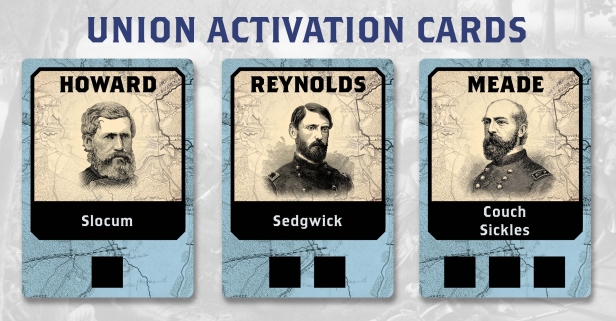
Maurice: I wanted to retain the same 15 activations per side per game – because this feels like a good duration for the game, and paced it well.
In order to do this, and to give each formation enough opportunities to feature in the campaign, I needed to create a major/minor activation concept. This is especially necessary for the Union side who has more units to move, and farther to move them to put pressure on objective locations.
Major activations let those units move two spaces, whereas minor activations only let you move one. In each case you pay an activation cost (reduce Cohesion by 1.)
With a major activation, if you only move one space and attack you can attack the same space again without an activation cost, or move to/attack a different adjacent space without an activation cost.
Grant: Prepared positions are also a new addition. How do these work and why did you include them?
Maurice: On an activation, instead of moving/attacking and paying an activation cost you can prepare defenses. You can never have more than 3 prepared defenses (or redoubts as they are also known in the game) in the same location.
When it comes to combat, before an attacker rolls their dice, at the cost of one redoubt per dice, the defender may set one dice (before it is rolled) to any face they like. The attacker cannot alter this dice face for the remainder of the turn.
I included this idea because there are frequently times in the strategic situation – especially for the Confederates – when staying put is the best response to win the game. This is clearly not very fun for that player. So I wanted to make sure that player had something meaningful to do. Prepared defenses addresses that. They were also a feature of the campaign that I felt required some modelling.
Grant: Can you show us some examples of the Tactics Cards?
Maurice: Of the 16 new Tactics cards here are some:
| 2* | Interior Lines of Communication (Use once) | 2 | Any chosen formation not in contact with the enemy may move 1 space, but it must not be into combat. There is no activation cost for this. | PLAY ANYTIME. |
| 9* | Scouts (Use once) | 2 | Choose any location within 2 spaces of any friendly formation. Enemy must reveal if a formation is present. If it is, place unit and remove at end of next player turn if it out of contact with the enemy. | PLAY ANYTIME. |
| 17* | Relocate (Use once) | 2 | Activated unit may swap places with any adjacent friendly formation, but neither formation may do anything else this turn. | PLAY DURING PLAYER’S ACTIVATION PHASE. |
| 22* | Cavalry (Use once) | 3 | Choose any location within 2 spaces of any friendly formation. Enemy must reveal if a formation is present. If it is, place unit and remove at end of next player turn if out of contact with the enemy. Additionally -1 Cohesion to that formation. | PLAY ANYTIME. |
| 24* | Coup d’enfer (Use once) | 5 | Removes up to 2 Prepared Defensive Position cubes in a selected space that must be adjacent to a friendly formation. | PLAY ANYTIME. |
| 26* | Rush Reinforcements (Use once) | 3 | Transfer up to 2 Cohesion points between any 2 adjacent friendly formations. | PLAY ANYTIME. |
| 31* | General Incapacitated (Use once) | 6 | Concussion from shelling prevents enemy from using General card for remainder on the battle (unless Back in the Saddle is played on them). | PLAY ANYTIME. |
(This is what happened to Hooker.)
| 32* | Jackson Shot
(Use once) |
6 | If first ability on General Jackson card has been played, the second part of his ability may no longer be used. | PLAY ANYTIME. |
| 35* | Night March (Use once) | 3 | Any chosen formation may immediately move up to 2 spaces (but not into combat). May not be played if enemy has just moved into combat with this formation. | PLAY ANYTIME. |
| 36* | Artillery smoke screen | 5 | Any chosen formation may immediately reduce an adjacent formation by 1 Cohesion and move up to 2 spaces (but not into combat). May not be played if enemy has just moved into combat with this formation. | PLAY ANYTIME. |
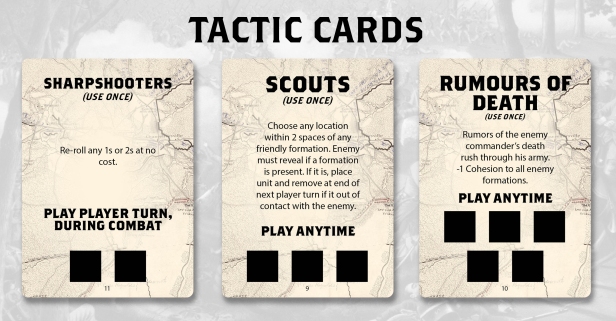
Grant: What other games do you envision using this system in?
Maurice: I’m working on a game on the battle of White Mountain with a friend, Adrian Earle – in fact he’s been leading the design on that and I’ve been helping out. It was a key battle of the Thirty Years War. Like Freeman’s Farm, it’s an essentially tactical battle without much movement, its’ about control and pressure – and running away. There are a couple of unique design elements in play here too.
I’ll also be looking at Leipzig and Waterloo in the summer – again with hidden movement.
Grant: What has been the experience of your playtesters?
Maurice: Very positive so far. People have really enjoyed hidden movement, even though usually by about a third of the way into the game most units are all on the main map, they say it makes the set up feel exciting. They’ve also found the game really fast to pick up and play.
Here’s one direct quote I have:
So far loving it. The hidden movement adds a whole new element to the Freeman’s Farm feel of the game. Not only that, just the maneuver adds a lot to the game. The cards are well thought out and the movement even more so. With limited activations per command you have to take full advantage of the opportunities when you get them.
I’m really looking forward to getting it to Prezcon in February – the quality of playtesting there is extremely high and will help kick the tires on the game.
Grant: What do you think the game does well?
Maurice: It’s easy to pick up, fast to play, and people have been really responding well to how hidden movement is executed.
I think it reminds people that wargames can be fun and accessible, and this doesn’t mean dumbing them down, it means refocusing your design lens on key elements with greater elegance and efficiency.
In wargames I often find combat resolution the least fun part – which is a shame – because it ought to be fun, and ought to make you feel most involved in the game. Like Freeman’s Farm, I think it helps make combat feel better – giving you tricky choices, but with a degree of control – even if it pendulums away from you pretty often too.
Grant: When does Worthington anticipate fulfilling this one when successfully funded?
Maurice: Three months out from a successful campaign.
Grant: What other designs are you working on?
Maurice: Aside from the other games mentioned above with the Freeman’s Farm/Battle Formations System, I’m working on a new game in the Worthington Great Sieges Series, following up on their 1759: The Siege of Quebec. Mine’s on the Great Siege of Malta 1565.
I’m working on a co-op game about being a diplomat in July 1914 and trying to stop world war from breaking out. It also works for solo play and with up to 5 players.
I’m also working on a number of games in a new series for Worthington called Hidden Strike – which are semi-co-op games (with hidden traitor modes) covering a range of topics. They are all also playable solo, and can be played in other modes too – like 1v1, and 1v many. The first in this series will be on the American Revolution.
My website is www.mauricesuckling.com.
On Twitter I’m @writegameread
In our personal opinion Maurice is a brilliant designer and a great guy to work with. We’ve got a number of other games we are working on with him and really are looking forward to all of them. They are all in different stages of art, with some more along in production than others, but he is truly a great guy. We think he is currently one of the most innovative designers going, not being locked into the traditional mindset of design.
– Grant and Mike Wylie
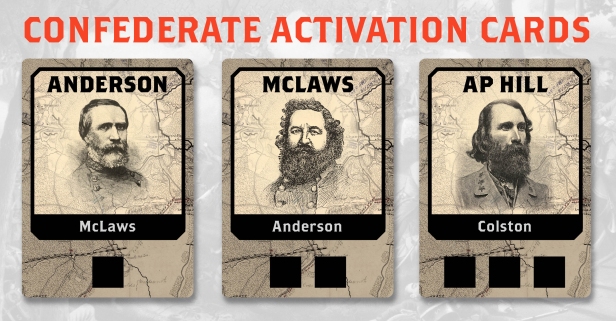
Thank you for your time Maurice in talking with us about your upcoming games as well as your philosophy and approach to design. I for one have really enjoyed your Freeman’s Farm 1777 and really look forward to what else you have up your sleeve as I found the game and its systems really interesting and refreshing.
If you are interested in Chancellorsville 1863 you can order a copy on the Kickstarter page from the following link: https://www.kickstarter.com/projects/1040417273/2785622?ref=3mro1o&token=b117acc9
-Grant
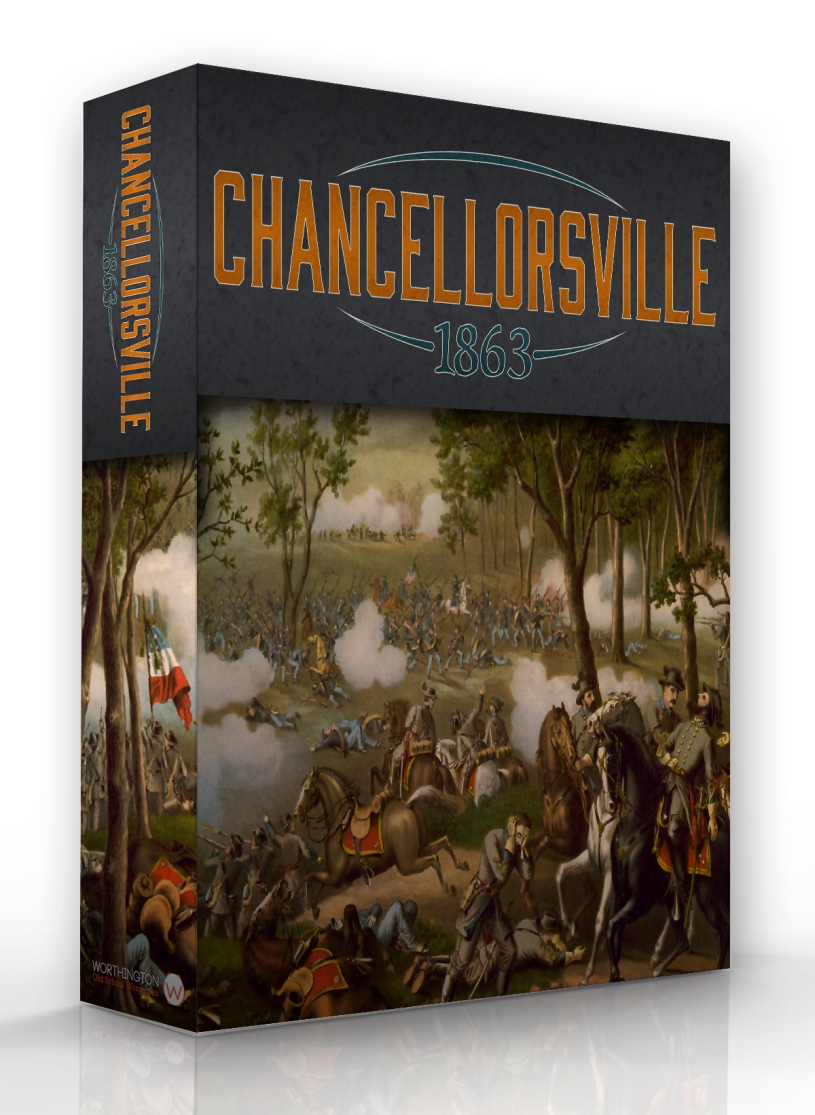
Here’s where I normally just say “Thanks” but I have a boatload of ACW games from Battle Cry (Milton Bradley and beyond) to Moseby’s Raiders (Victory Point), to Columbia’s five ACW games (Shenandoah, Bobby Lee, Sam Grant, Shiloh, Gettysburg, etc) PLUS two “Coffin Box” AH games from back in the day. BUT… this Brigade series business has me somewhat intrigued. The production quality is high, the attrition looks organic and not arbitrary. I love “hidden movement” when someone can figure out how to get it right. I’ll put it on my BUY LIST… I look forward to your usual unboxing and review… when it comes. Thanks again…
LikeLiked by 1 person